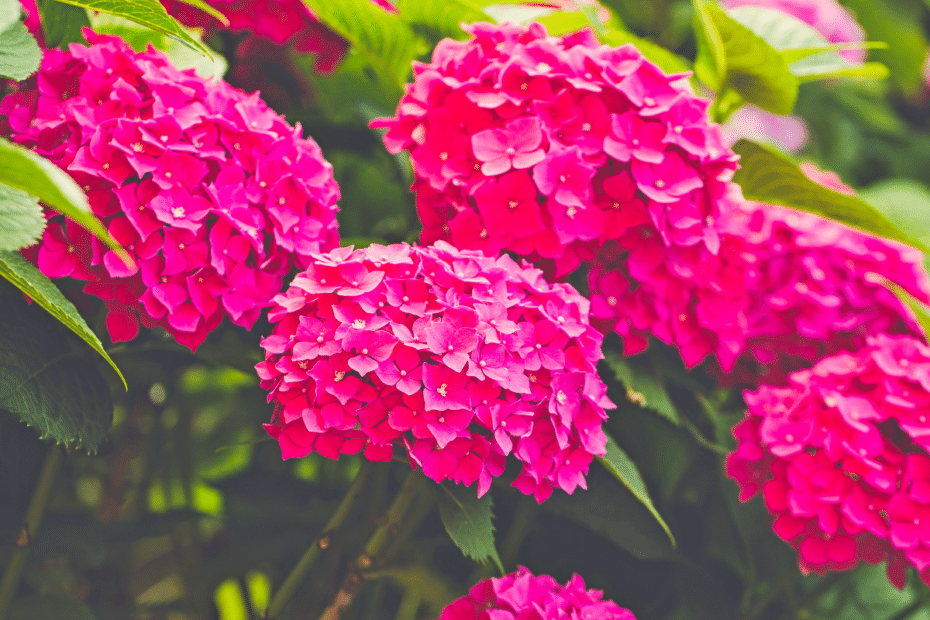Hydrangeas are a popular choice in gardens due to their stunning, vibrant blooms that grace our gardens each spring and summer. As the months progress, it’s essential to give your hydrangeas proper care, ensuring a remarkable display of blossoms when the time comes.
Contenus de la page
April hydrangea care checklist
- Meticulously prune faded flowers
- Protect against late frosts
- Maintain protective mulch
- Apply balanced fertilizer
- Water regularly
- Choose appropriate sunlight exposure
- Adapt care to match hydrangea variety
- Monitor and treat pests as needed
Here are 8 essential steps you can take to care for hydrangeas in April, for spectacular results.
1/ Prune faded flowers
In April, you should remove any faded flowers from your hydrangeas by cutting them just above the first set of buds, promoting new growth and allowing the plant to focus its energy on more significant areas. This process is known as meticulous pruning.
2/ Protect against late frosts
Even in April, some areas may still experience frost or a sudden drop in temperature, which can potentially damage delicate hydrangea buds. Hence, it is necessary to protect your plants against late frost by using breathable winter protection cloths that allow air and moisture circulation. Avoid using plastic materials as they can create unwanted humidity around the plants.
When to use frost protection
- Check weather forecasts: Stay updated on local weather conditions to ensure timely protection
- Sudden temperature drops: Cold temperatures might harm tender buds and foliage – always be prepared!
- Keep an eye on specific varieties: Some hydrangea cultivars may require additional protection from sudden cold snaps
3/ Maintain mulch for soil warmth preservation
Throughout April, it is essential to maintain a layer of mulch around the base of your hydrangeas. This protective mulch helps keep the soil warm by preventing excessive heat loss, which can ultimately benefit the health and growth of your plants. Opt for organic materials such as straw, dead leaves or bark to ensure an environmentally friendly choice.
4/ Apply balanced fertilizer
In early spring, apply a balanced fertilizer optimized for spring-flowering shrubs. This will provide the essential nutrients that hydrangeas need for robust new growth and flower formation. Choose a fertilizer containing a balanced ratio of macro-nutrients like nitrogen, phosphorus, and potassium for optimal results.
5/ Water regularly
Consistent watering is essential for healthy hydrangea growth, even during cooler months. In April, be sure to provide sufficient water to keep the roots hydrated and prevent stress on the plant. Water at the base of the plant to avoid wetting the foliage, which can lead to fungal problems.
6/ Ensure proper sunlight exposure
Observing your hydrangeas’ behavior throughout the seasons can help determine if they are receiving the correct amount of light. Some varieties may require more shade, while others prefer full sunlight. Make necessary adjustments in their location, keeping in mind each specific cultivar’s needs.
7/ Adapt care to match hydrangea variety
Different types of hydrangeas may have specific care requirements. Be attentive to these needs, whether it be additional cold protection, specialized fertilization, or differing amounts of sunlight. By catering your care to the unique variety you’ve chosen, you’re giving your hydrangea the best possible chance for success!
8/ Monitor and treat pests as needed
Even in April, keep an eye out for pests such as aphids or scale insects that can inflict damage on your hydrangeas. Employ environmentally friendly treatment methods like insecticidal soap to combat these invaders without negatively impacting the wider ecosystem.
In conclusion, following the eight essential actions outlined above will help ensure a healthy and beautiful display of hydrangea blooms come spring and summer. Empower yourself with ongoing knowledge and make adjustments when necessary to provide your plants the best chance of success!


